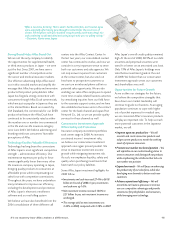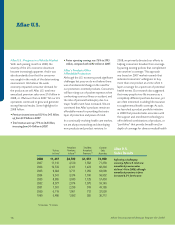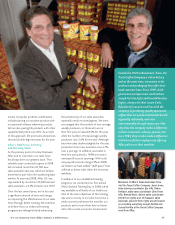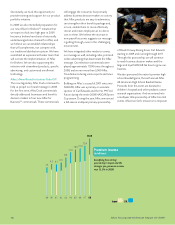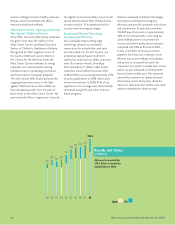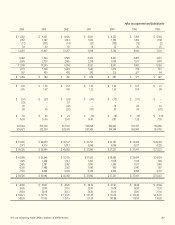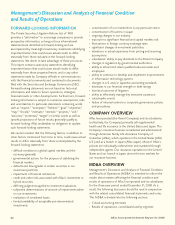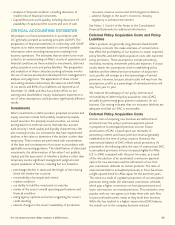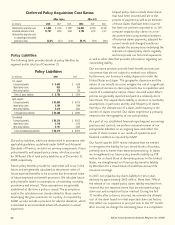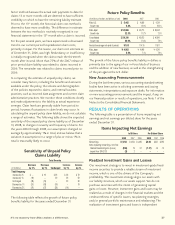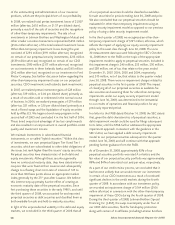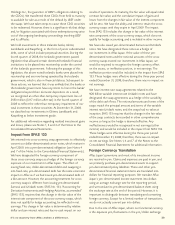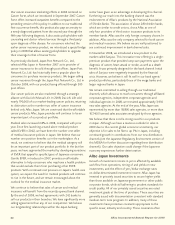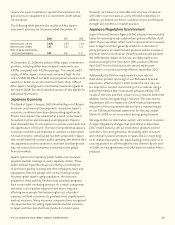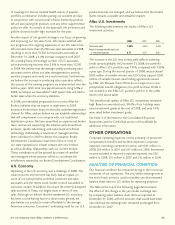Aflac 2008 Annual Report Download - page 29
Download and view the complete annual report
Please find page 29 of the 2008 Aflac annual report below. You can navigate through the pages in the report by either clicking on the pages listed below, or by using the keyword search tool below to find specific information within the annual report.
25
It’s no mystery how Aflac makes a difference.
• Analysis of financial condition, including discussion of
market risks of financial instruments
• Capital Resources and Liquidity, including discussion of
availability of capital and the sources and uses of cash
CRITICAL ACCOUNTING ESTIMATES
We prepare our financial statements in accordance with
U.S. generally accepted accounting principles (GAAP). The
preparation of financial statements in conformity with GAAP
requires us to make estimates based on currently available
information when recording transactions resulting from
business operations. The estimates that we deem to be most
critical to an understanding of Aflac’s results of operations and
financial condition are those related to investments, deferred
policy acquisition costs and policy liabilities. The preparation
and evaluation of these critical accounting estimates involve
the use of various assumptions developed from management’s
analyses and judgments. The application of these critical
accounting estimates determines the values at which 96%
of our assets and 86% of our liabilities are reported as of
December 31, 2008, and thus has a direct effect on net
earnings and shareholders’ equity. Subsequent experience or
use of other assumptions could produce significantly different
results.
Investments
Aflac’s investments in debt securities, perpetual securities and
equity securities include both publicly issued and privately
issued securities. For privately issued securities, we receive
pricing data from external sources that take into account
each security’s credit quality and liquidity characteristics. We
also routinely review our investments that have experienced
declines in fair value to determine if the decline is other than
temporary. These reviews are performed with consideration
of the facts and circumstances of an issuer in accordance with
applicable accounting guidance. The identification of distressed
investments, the determination of fair value if not publicly
traded, and the assessment of whether a decline is other than
temporary involve significant management judgment and
require evaluation of factors, including but not limited to:
• percentage decline in value and the length of time during
which the decline has occurred
• recoverability of principal and interest
• market conditions
• our ability to hold the investment to maturity
• review of the issuer’s overall operating performance and
financial condition
• rating agency opinions and actions regarding the issuer’s
credit standing
• adverse changes in the issuer’s availability of production
resources, revenue sources and technological conditions
• adverse changes in the issuer’s economic, industry,
regulatory or political environment
See Notes 1, 3 and 4 of the Notes to the Consolidated
Financial Statements for additional information.
Deferred Policy Acquisition Costs and Policy
Liabilities
Aflac’s products are generally long-duration fixed-benefit
indemnity contracts. We make estimates of certain factors
that affect the profitability of our business to match expected
policy benefits and deferrable acquisition costs with expected
policy premiums. These assumptions include persistency,
morbidity, mortality, investment yields and expenses. If actual
results match the assumptions used in establishing policy
liabilities and the deferral and amortization of acquisition
costs, profits will emerge as a level percentage of earned
premiums. However, because actual results will vary from the
assumptions, profits as a percentage of earned premiums will
vary from year to year.
We measure the adequacy of our policy reserves and
recoverability of deferred policy acquisition costs (DAC)
annually by performing gross premium valuations on our
business. Our testing indicates that our insurance liabilities are
adequate and that our DAC is recoverable.
Deferred Policy Acquisition Costs
Certain costs of acquiring new business are deferred and
amortized over the policy’s premium payment period
in proportion to anticipated premium income. Future
amortization of DAC is based upon our estimates of
persistency, interest and future premium revenue generally
established at the time of policy issuance. However, the
unamortized balance of DAC reflects actual persistency. As
presented in the following table, the ratio of unamortized DAC
to annualized premiums in force increased slightly for Aflac
U.S. in 2008, compared with the prior two years, as a result
of the introduction of an accelerated commission payment
option for new associates and the refinement of our first-
year commission deferrals on certain products. The ratio of
unamortized DAC to annualized premiums in force has shown
a slight upward trend for Aflac Japan for the last three years.
This trend is a result of a greater proportion of our annualized
premiums being under the alternative commission schedule,
which pays a higher commission on first-year premiums and
lower commissions on renewal premiums. This schedule is very
popular with our new agents as it helps them with cash flow
for personal and business needs as they build their business.
While this has resulted in a higher unamortized DAC balance,
the overall cost to the company has been reduced.


